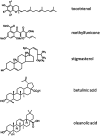Biological and therapeutic relevance of nonreplicative DNA polymerases to cancer
- PMID: 22794079
- PMCID: PMC3557440
- DOI: 10.1089/ars.2011.4203
Biological and therapeutic relevance of nonreplicative DNA polymerases to cancer
Abstract
Apart from surgical approaches, the treatment of cancer remains largely underpinned by radiotherapy and pharmacological agents that cause damage to cellular DNA, which ultimately causes cancer cell death. DNA polymerases, which are involved in the repair of cellular DNA damage, are therefore potential targets for inhibitors for improving the efficacy of cancer therapy. They can be divided, according to their main function, into two groups, namely replicative and nonreplicative enzymes. At least 15 different DNA polymerases, including their homologs, have been discovered to date, which vary considerably in processivity and fidelity. Many of the nonreplicative (specialized) DNA polymerases replicate DNA in an error-prone fashion, and they have been shown to participate in multiple DNA damage repair and tolerance pathways, which are often aberrant in cancer cells. Alterations in DNA repair pathways involving DNA polymerases have been linked with cancer survival and with treatment response to radiotherapy or to classes of cytotoxic drugs routinely used for cancer treatment, particularly cisplatin, oxaliplatin, etoposide, and bleomycin. Indeed, there are extensive preclinical data to suggest that DNA polymerase inhibition may prove to be a useful approach for increasing the effectiveness of therapies in patients with cancer. Furthermore, specialized DNA polymerases warrant examination of their potential use as clinical biomarkers to select for particular cancer therapies, to individualize treatment for patients.
Figures










Similar articles
-
Biological relevance of DNA polymerase β and translesion synthesis polymerases to cancer and its treatment.Curr Mol Pharmacol. 2012 Jan;5(1):54-67. Curr Mol Pharmacol. 2012. PMID: 22122464 Review.
-
The overexpression of specialized DNA polymerases in cancer.DNA Repair (Amst). 2005 May 2;4(5):583-93. doi: 10.1016/j.dnarep.2005.01.005. DNA Repair (Amst). 2005. PMID: 15811630
-
Repair and translesion DNA polymerases as anticancer drug targets.Anticancer Agents Med Chem. 2008 May;8(4):431-47. doi: 10.2174/187152008784220348. Anticancer Agents Med Chem. 2008. PMID: 18473728 Review.
-
DNA polymerases and cancer.Nat Rev Cancer. 2011 Feb;11(2):96-110. doi: 10.1038/nrc2998. Nat Rev Cancer. 2011. PMID: 21258395 Free PMC article. Review.
-
Translesion DNA Synthesis and Reinitiation of DNA Synthesis in Chemotherapy Resistance.Biochemistry (Mosc). 2020 Aug;85(8):869-882. doi: 10.1134/S0006297920080039. Biochemistry (Mosc). 2020. PMID: 33045948 Review.
Cited by
-
Comparative Molecular Dynamics Studies of Human DNA Polymerase η.J Chem Inf Model. 2015 Dec 28;55(12):2672-81. doi: 10.1021/acs.jcim.5b00606. Epub 2015 Nov 20. J Chem Inf Model. 2015. PMID: 26562587 Free PMC article.
-
Relative Binding Free Energies of Adenine and Guanine to Damaged and Undamaged DNA in Human DNA Polymerase η: Clues for Fidelity and Overall Efficiency.J Am Chem Soc. 2015 Oct 21;137(41):13240-3. doi: 10.1021/jacs.5b08451. Epub 2015 Oct 12. J Am Chem Soc. 2015. PMID: 26434497 Free PMC article.
-
Precision genome editing using synthesis-dependent repair of Cas9-induced DNA breaks.Proc Natl Acad Sci U S A. 2017 Dec 12;114(50):E10745-E10754. doi: 10.1073/pnas.1711979114. Epub 2017 Nov 28. Proc Natl Acad Sci U S A. 2017. PMID: 29183983 Free PMC article.
-
Modulating the DNA polymerase β reaction equilibrium to dissect the reverse reaction.Nat Chem Biol. 2017 Oct;13(10):1074-1080. doi: 10.1038/nchembio.2450. Epub 2017 Jul 31. Nat Chem Biol. 2017. PMID: 28759020 Free PMC article.
-
PrimPol: A Breakthrough among DNA Replication Enzymes and a Potential New Target for Cancer Therapy.Biomolecules. 2022 Feb 3;12(2):248. doi: 10.3390/biom12020248. Biomolecules. 2022. PMID: 35204749 Free PMC article. Review.
References
-
- Adachi M. Ijichi K. Hasegawa Y. Ogawa T. Nakamura H. Yasui Y. Fukushima M. Ishizaki K. Hypersensitivity to cisplatin after hRev3 mRNA knockdown in head and neck squamous cell carcinoma cells. Mol Med Report. 2008;1:695–698. - PubMed
-
- Albertella MR. Green CM. Lehmann AR. O'Connor MJ. A role for polymerase eta in the cellular tolerance to cisplatin-induced damage. Cancer Res. 2005;65:9799–9806. - PubMed
Publication types
MeSH terms
Substances
Grants and funding
LinkOut - more resources
Full Text Sources
Other Literature Sources

